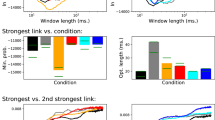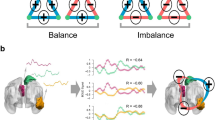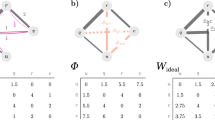Abstract
Networks in nature do not act in isolation, but instead exchange information and depend on one another to function properly1,2,3. Theory has shown that connecting random networks may very easily result in abrupt failures3,4,5,6. This finding reveals an intriguing paradox7,8: if natural systems organize in interconnected networks, how can they be so stable? Here we provide a solution to this conundrum, showing that the stability of a system of networks relies on the relation between the internal structure of a network and its pattern of connections to other networks. Specifically, we demonstrate that if interconnections are provided by network hubs, and the connections between networks are moderately convergent, the system of networks is stable and robust to failure. We test this theoretical prediction on two independent experiments of functional brain networks (in task and resting states), which show that brain networks are connected with a topology that maximizes stability according to the theory.
This is a preview of subscription content, access via your institution
Access options
Subscribe to this journal
Receive 12 print issues and online access
$259.00 per year
only $21.58 per issue
Buy this article
- Purchase on SpringerLink
- Instant access to full article PDF
Prices may be subject to local taxes which are calculated during checkout




Similar content being viewed by others
References
Little, R. G. Controlling cascading failure: Understanding the vulnerabilities of interconnected infrastructures. J. Urban Technol. 9, 109–123 (2002).
Rosato, V. Modeling interdependent infrastructures using interacting dynamical models. Int. J. Crit. Infrastruct. 4, 63–79 (2008).
Buldyrev, S. V., Parshani, R., Paul, G., Stanley, H. E. & Havlin, S. Catastrophic cascade of failures in interdependent networks. Nature 464, 1025–1028 (2010).
Leicht, E. A. & D’Souza, R. M. Percolation on interacting networks. Preprint at http://arxiv.org/abs/0907.0894 (2009).
Brummitt, C. D., D’Souza, R. M. & Leicht, E. A. Suppressing cascades of load in interdependent networks. Proc. Natl Acad. Sci. USA 109, E680–E689 (2012).
Gao, J., Buldyrev, S. V., Stanley, H. E. & Havlin, S. Networks formed from interdependent networks. Nature Phys. 8, 40–48 (2012).
Bianconi, G., Dorogovtsev, S. N. & Mendes, J. F. F. Mutually connected component of network of networks. Preprint at http://arxiv.org/abs/1402.0215 (2014).
Bianconi, G. & Dorogovtsev, S. N. Multiple percolation transitions in a configuration model of network of networks. Phys. Rev. E 89, 062814 (2014).
Dosenbach, N. U. F. et al. Distinct brain networks for adaptive and stable task control in humans. Proc. Natl Acad. Sci. USA 104, 11073–11078 (2007).
Vidal, M., Cusick, M. E. & Barabási, A-L. Interactome networks and human disease. Cell 144, 986–998 (2011).
Pastor-Satorras, R., Vázquez, A. & Vespignani, A. Dynamical and correlation properties of the Internet. Phys. Rev. Lett. 87, 258701 (2001).
Gallos, L. K., Song, C. & Makse, H. A. Scaling of degree correlations and its influence on diffusion in scale-free networks. Phys. Rev. Lett. 100, 248701 (2008).
Radicchi, F. Driving interconnected networks to supercriticality. Phys. Rev. X 4, 021014 (2014).
Gallos, L. K., Makse, H. A. & Sigman, M. A small world of weak ties provides optimal global integration of self-similar modules in functional brain networks. Proc. Natl Acad. Sci. USA 109, 2825–2830 (2012).
Moore, C. & Newman, M. E. J. Exact solution of site and bond percolation on small-world networks. Phys. Rev. E 62, 7059–7064 (2000).
Gao, J., Buldyrev, S. V., Havlin, S. & Stanley, H. E. Robustness of a network formed by n interdependent networks with a one-to-one correspondence of dependent nodes. Phys. Rev. E 85, 066134 (2012).
Bollobás, B. Random Graphs (Academic, 1985).
Cohen, R., Ben-Avraham, D. & Havlin, S. Percolation critical exponents in scale-free networks. Phys. Rev. E 66, 036113 (2002).
Eguiluz, V. M., Chialvo, D. R., Cecchi, G. A., Baliki, M. & Apkarian, A. V. Scale-free brain functional networks. Phys. Rev. Lett. 94, 018102 (2005).
Bullmore, E. & Sporns, O. Complex brain networks: Graph theoretical analysis of structural and functional systems. Nature Rev. Neurosci. 10, 186–198 (2009).
Sigman, M. et al. Top-down reorganization of activity in the visual pathway after learning a shape identification task. Neuron 46, 823–835 (2005).
Shehzad, Z., Kelly, A. M. C. & Reiss, P. T. The resting brain: Unconstrained yet reliable. Cereb. Cortex 10, 2209–2229 (2009).
Sigman, M. & Dehaene, S. Brain mechanisms of serial and parallel processing during dual-task performance. J. Neurosci. 28, 7585–7598 (2008).
Russo, R., Herrmann, H. J. & de Arcangelis, L. Brain modularity controls the critical behavior of spontaneous activity. Sci. Rep. 4, 4312 (2014).
Gallos, L. K., Sigman, M. & Makse, H. A. The conundrum of functional brain networks: small-world efficiency or fractal modularity. Front. Physiol. 3, 123 (2012).
Honey, C. J. et al. Predicting human resting-state functional connectivity from structural connectivity. Proc. Natl Acad. Sci. USA 106, 2035–2040 (2009).
Schneider, C. M., Yazdani, N., Araújo, N. A. M., Havlin, S. & Herrmann, H. J. Towards designing robust coupled networks. Sci. Rep. 3, 1969 (2013).
Schneidman, E., Berry, M. J., Segev, R. & Bialek, W. Weak pairwise correlations imply strongly correlated network states in a neural population. Nature 440, 1007–1012 (2006).
Clauset, A., Shalizi, C. R. & Newman, M. E. J. Power-law distributions in empirical data. SIAM Rev. 51, 661–703 (2009).
Acknowledgements
This work was funded by NSF-PoLS PHY-1305476 and NIH-NIGMS 1R21GM107641. We thank N. A. M. Araújo, S. Havlin, L. Parra, L. Gallos, A. Salles and T. Bekinschtein for clarifying discussions. Additional financial support was provided by the Brazilian agencies CNPq, CAPES and FUNCAP, the Spanish MINECO BFU2012-39958, CONICET and the James McDonnell Foundation 21st Century Science Initiative in Understanding Human Cognition—Scholar Award. The Instituto de Neurociencias is a Severo Ochoa center of excellence.
Author information
Authors and Affiliations
Contributions
All authors contributed equally to the work presented in this paper.
Corresponding author
Ethics declarations
Competing interests
The authors declare no competing financial interests.
Supplementary information
Supplementary Information
Supplementary Information (PDF 780 kb)
Rights and permissions
About this article
Cite this article
Reis, S., Hu, Y., Babino, A. et al. Avoiding catastrophic failure in correlated networks of networks. Nature Phys 10, 762–767 (2014). https://doi.org/10.1038/nphys3081
Received:
Accepted:
Published:
Issue date:
DOI: https://doi.org/10.1038/nphys3081
This article is cited by
-
The dynamic nature of percolation on networks with triadic interactions
Nature Communications (2023)
-
Portfolio Correlations in the Bank-Firm Credit Market of Japan
Computational Economics (2022)
-
Internetwork connectivity of molecular networks across species of life
Scientific Reports (2021)
-
Greedy control of cascading failures in interdependent networks
Scientific Reports (2021)
-
The structure and behaviour of hierarchical infrastructure networks
Applied Network Science (2021)



